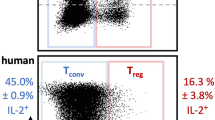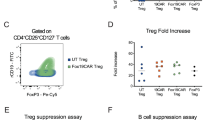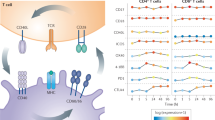Abstract
Humans and mice deficient in Fas, a tumor necrosis factor (TNF)-receptor family member, cannot induce apoptosis of autoreactive cells, and consequently develop progressive lymphoproliferative disorders and lupus-like autoimmune diseases. Previous studies have shown that short-term administrations of agonistic monoclonal antibodies against CD137, another TNF-receptor family member, activate T cells and induce rejection of allografts and established tumors. Here we report that treatment with an agonistic monoclonal antibody to CD137 (2A) blocks lymphadenopathy and spontaneous autoimmune diseases in Fas-deficient MRL/lpr mice, ultimately leading to their prolonged survival. Notably, 2A treatment rapidly augments IFN-γ production, and induces the depletion of autoreactive B cells and abnormal double-negative T cells, possibly by increasing their apoptosis through Fas- and TNF receptor–independent mechanisms. This study demonstrates that agonistic monoclonal antibodies specific for costimulatory molecules can be used as novel therapeutic agents to delete autoreactive lymphocytes and block autoimmune disease progression.
This is a preview of subscription content, access via your institution
Access options
Subscribe to this journal
Receive 12 print issues and online access
$209.00 per year
only $17.42 per issue
Buy this article
- Purchase on Springer Link
- Instant access to full article PDF
Prices may be subject to local taxes which are calculated during checkout






Similar content being viewed by others
References
Theofilopoulos, A.N. & Dixon, F.J. Etiopathogenesis of murine SLE. Immunol. Rev. 55, 179–216 (1981).
Cohen, P.L. & Eisenberg, R.A. Lpr and gld: Single gene models of systemic autoimmunity and lymphoproliferative disease. Annu. Rev. Immunol. 9, 243–269 (1991).
Wofsy, D., Hardy, R.R. & Seaman, W.E. The proliferating cells in autoimmune MRL/lpr mice lack L3T4, an antigen on “helper” T cells that is involved in the response to class II major histocompatibility antigens. J. Immunol. 132, 2686–2689 (1984).
Morse, H.C. 3rd et al. Abnormalities induced by the mutant gene Ipr: Expansion of a unique lymphocyte subset. J. Immunol. 129, 2612–2615 (1982).
Andrews, B.S. et al. Spontaneous murine lupus-like syndromes. Clinical and immunopathological manifestations in several strains. J. Exp. Med. 148, 1198–1215 (1978).
Kaliyaperumal, A., Michaels, M.A. & Datta, S.K. Antigen-specific therapy of murine lupus nephritis using nucleosomal peptides: Tolerance spreading impairs pathogenic function of autoimmune T and B cells. J. Immunol. 162, 5775–5783 (1999).
Wofsy, D. Treatment of murine lupus with anti-CD4 monoclonal antibodies. Immunol. Ser. 59, 221–236 (1993).
Mohan, C., Shi, Y., Laman, J.D. & Datta, S.K. Interaction between CD40 and its ligand gp39 in the development of murine lupus nephritis. J. Immunol. 154, 1470–80 (1995).
Finck, B.K., Linsley, P.S. & Wofsy, D. Treatment of murine lupus with CTLA4Ig. Science 265, 1225–1227 (1994).
Kalled, S.L., Cutler, A.H., Datta, S.K. & Thomas, D.W. Anti-CD40 ligand antibody treatment of SNF1 mice with established nephritis: Preservation of kidney function. J. Immunol. 160, 2158–2165 (1998).
Liang, B., Kashgarian, M.J., Sharpe, A.H. & Mamula, M.J. Autoantibody responses and pathology regulated by B7-1 and B7-2 costimulation in MRL/lpr lupus. J. Immunol. 165, 3436–3443 (2000).
Theofilopoulos, A.N. & Lawson, B.R. Tumour necrosis factor and other cytokines in murine lupus. Ann. Rheum. Dis. 58 Suppl. 1, I49–55 (1999).
Kelley, V.R. & Wuthrich, R.P. Cytokines in the pathogenesis of systemic lupus erythematosus. Semin. Nephrol. 19, 57–66 (1999).
Lawson, B.R. et al. Treatment of murine lupus with cDNA encoding IFN-γR/Fc. J. Clin. Invest. 106, 207–215 (2000).
Vinay, D.S. & Kwon, B.S. Role of 4-1BB in immune responses. Semin. Immunol. 10, 481–489 (1998).
Kwon, B., Moon, C.H., Kang, S., Seo, S.K. & Kwon, B.S. 4-1BB: Still in the midst of darkness. Mol. Cells 10, 119–126 (2000).
Pollok, K.E. et al. Inducible T cell antigen 4-1BB. Analysis of expression and function. J. Immunol. 150, 771–781 (1993).
Melero, I., Johnston, J.V., Shufford, W.W., Mittler, R.S. & Chen, L. NK1.1 cells express 4-1BB (CDw137) costimulatory molecule and are required for tumor immunity elicited by anti-4-1BB monoclonal antibodies. Cell. Immunol. 190, 167–172 (1998).
Goodwin, R.G. et al. Molecular cloning of a ligand for the inducible T cell gene 4-1BB: A member of an emerging family of cytokines with homology to tumor necrosis factor. Eur. J. Immunol. 23, 2631–2641 (1993).
Pollok, K.E. et al. 4-1BB T-cell antigen binds to mature B cells and macrophages, and costimulates anti-μ-primed splenic B cells. Eur. J. Immunol. 24, 367–374 (1994).
Alderson, M.R. et al. Molecular and biological characterization of human 4-1BB and its ligand. Eur. J. Immunol. 24, 2219–2227 (1994).
Melero, I. et al. Monoclonal antibodies against the 4-1BB T-cell activation molecule eradicate established tumors. Nature Med. 3, 682–685 (1997).
Shuford, W.W. et al. 4-1BB costimulatory signals preferentially induce CD8+ T cell proliferation and lead to the amplification in vivo of cytotoxic T cell responses. J. Exp. Med. 186, 47–55 (1997).
Blazar, B.R. et al. Ligation of 4-1BB (CDw137) regulates graft-versus-host disease, graft- versus-leukemia, and graft rejection in allogeneic bone marrow transplant recipients. J. Immunol. 166, 3174–3183 (2001).
Wilcox, R. et al. Provision of antigen and CD137 signaling breaks immunological ignorance, promoting regression of poorly immunogenic tumors. J. Clin. Invest. 109, 651–659 (2002).
Halstead, E.S., Mueller, Y.M., Altman, J.D. & Katsikis, P.D. In vivo stimulation of CD137 broadens primary antiviral CD8+ T cell responses. Nature Immunol. 3, 536–541 (2002).
Mittler, R.S., Bailey, T.S., Klussman, K., Trailsmith, M.D. & Hoffmann, M.K. Anti-4-1BB monoclonal antibodies abrogate T cell-dependent humoral immune responses in vivo through the induction of helper T cell anergy. J. Exp. Med. 190, 1535–1540 (1999).
Sun, Y. et al. Administration of agonistic anti-4-1BB monoclonal antibody leads to the amelioration of experimental autoimmune encephalomyelitis. J. Immunol. 168, 1457–1465 (2002).
Adachi, M., Watanabe-Fukunaga, R. & Nagata, S. Aberrant transcription caused by the insertion of an early transposable element in an intron of the Fas antigen gene of lpr mice. Proc. Natl. Acad. Sci. USA 90, 1756–1760 (1993).
Suda, T. & Nagata, S. Why do defects in the Fas-Fas ligand system cause autoimmunity? J. Allergy Clin. Immunol. 100, S97–101 (1997).
Hildeman, D.A. et al. Reactive oxygen species regulate activation-induced T cell apoptosis. Immunity 10, 735–744 (1999).
Ding, A.H., Nathan, C.F. & Stuehr, D.J. Release of reactive nitrogen intermediates and reactive oxygen intermediates from mouse peritoneal macrophages. Comparison of activating cytokines and evidence for independent production. J. Immunol. 141, 2407–2412 (1988).
Williams, M.S., Noguchi, S., Henkart, P.A. & Osawa, Y. Nitric oxide synthase plays a signaling role in TCR-triggered apoptotic death. J. Immunol. 161, 6526–6531 (1998).
Haendeler, J., Zeiher, A.M. & Dimmeler, S. Nitric oxide and apoptosis. Vitam. Horm. 57, 49–77 (1999).
Passwell, J., Schreiner, G.F., Nonaka, M., Beuscher, H.U. & Colten, H.R. Local extrahepatic expression of complement genes C3, factor B, C2, and C4 is increased in murine lupus nephritis. J. Clin. Invest. 82, 1676–1684 (1988).
Hoffman, R.W. T cells in the pathogenesis of systemic lupus erythematosus. Front Biosci. 6, D1369–1378 (2001).
Jacobson, B.A., Rothstein, T.L. & Marshak-Rothstein, A. Unique site of IgG2a and rheumatoid factor production in MRL/lpr mice. Immunol. Rev. 156, 103–110 (1997).
Peng, S.L., Moslehi, J. & Craft, J. Roles of interferon-γ and interleukin-4 in murine lupus. J. Clin. Invest. 99, 1936–1946 (1997).
Balomenos, D., Rumold, R. & Theofilopoulos, A.N. Interferon-γ is required for lupus-like disease and lymphoaccumulation in MRL-lpr mice. J. Clin. Invest. 101, 364–371 (1998).
Haas, C., Ryffel, B. & Le Hir, M. IFN-γ is essential for the development of autoimmune glomerulonephritis in MRL/Ipr mice. J. Immunol. 158, 5484–5491 (1997).
Schwarting, A., Wada, T., Kinoshita, K., Tesch, G. & Kelley, V.R. IFN-γ receptor signaling is essential for the initiation, acceleration, and destruction of autoimmune kidney disease in MRL- Fas(lpr) mice. J. Immunol. 161, 494–503 (1998).
Nicoletti, F. et al. Dichotomic effects of IFN-γ on the development of systemic lupus erythematosus-like syndrome in MRL-lpr/lpr mice. Eur. J. Immunol. 30, 438–447 (2000).
Wang, J. et al. The regulation of T cell homeostasis and autoimmunity by T cell-derived LIGHT. J. Clin. Invest. 108, 1771–1780 (2001).
Acknowledgements
This research was in part supported by NIH grants (HD-37104, DK-20595-25, and DK-58891) and JDFI (1-2000-875). J.C. was in part supported by the Howard Hughes Medical Institute undergraduate summer program.
Author information
Authors and Affiliations
Corresponding author
Ethics declarations
Competing interests
The authors declare no competing financial interests.
Rights and permissions
About this article
Cite this article
Sun, Y., Chen, H., Subudhi, S. et al. Costimulatory molecule-targeted antibody therapy of a spontaneous autoimmune disease. Nat Med 8, 1405–1413 (2002). https://doi.org/10.1038/nm1202-796
Received:
Accepted:
Published:
Issue Date:
DOI: https://doi.org/10.1038/nm1202-796
This article is cited by
-
Mechanisms utilized by feline adipose-derived mesenchymal stem cells to inhibit T lymphocyte proliferation
Stem Cell Research & Therapy (2019)
-
Beyond TNF: TNF superfamily cytokines as targets for the treatment of rheumatic diseases
Nature Reviews Rheumatology (2017)
-
Suppression of lupus nephritis and skin lesions in MRL/lpr mice by administration of the topoisomerase I inhibitor irinotecan
Arthritis Research & Therapy (2016)
-
Immune checkpoint receptors in regulating immune reactivity in rheumatic disease
Arthritis Research & Therapy (2014)
-
Advances in targeting cell surface signalling molecules for immune modulation
Nature Reviews Drug Discovery (2013)



